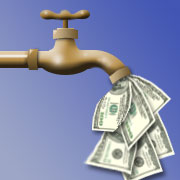Consider an Alternate Metric to Value Your Small Business
Posted on October 9th, 2015
Would you use a complicated discounted cash flow analysis to estimate the value of a mom-and-pop restaurant? How about using a price-to-earnings multiple derived from publicly traded restaurant chains? Neither method seems appropriate for a small family-operated eatery.
As this example illustrates, traditional valuation models don’t necessarily work for small businesses and professional practices. Instead, business appraisers and brokers typically recommend using an alternate metric for appraising small businesses known as “seller’s discretionary cash flow” (SDCF).
Public market data is less relevant for a small business that functions primarily as a “job” or steady source of income for its owner(s). Entrepreneurs go into business for different reasons than investors buy public stock. A small business owner appreciates the inherent values of being his or her own boss, employing family members, passing on a legacy to their heirs and expensing discretionary items (such as country club dues, business trips, company cars or season tickets to their favorite sports teams). In exchange for all these benefits and perks, small business owners are generally happy to give “sweat equity” so that their ventures might succeed.
Compute an Alternate Valuation Metric
When estimating the value of a small business or professional practice, it’s important to recognize the nature of the business. Is it a pure investment or a job that provides income and discretionary perks to the owner and his or her family and friends? If the latter description more closely aligns with your investment goals, then SDCF is generally a more meaningful metric of what the business is worth to you.
Computing SDCF starts with earnings before taxes. Then you adjust for:
- Non-operating income and expenses;
- Unusual or nonrecurring income and expenses;
- Depreciation and amortization expense;
- Interest income and expense;
- One owner’s total compensation;
- Above (or below) market rates paid to (or received from) related parties; and
- Discretionary expenses.
It’s important to identify and disclose everything that could be relevant to a potential buyer, including all discretionary expenditures which you, as the current owner, incur in the business. Although these may be legitimate expenses, such as business related meals with customers, they might not be expenses that a new owner would choose to incur. All benefits for the owner and other employees should be documented, so potential owners can see not only what benefits are available, but also what the approximate annual costs of these benefits are.
Once you’ve computed SDCF for the company, you can compare the business to other companies in the same industry (with comparable size, financial performance and geographic locations) that have recently been sold. Look at each comparable transaction and compute its SDCF-to-value multiple. These pricing multiples will give you a good sense of what a particular business might be worth in the current marketplace.
Recognize Dual Elements of Value
SDCF multiples derive value from all of the cash flows that are available to an individual business owner. Unlike methods used to value businesses that are pure investment plays, the SDCF method captures an owner’s return on investment and reasonable annual compensation. Both elements are valuable to the owner-operator of a small business.
Small business buyers are often focused on providing sufficient income for their livelihood; this is similar to dividend returns that stock investors receive each year. Conversely, sellers are interested in how potential buyers will perceive their business as an investment; this element is similar to the appreciation in value that public stock investors hope to achieve when they someday sell their stocks. Over the long run, every buyer eventually becomes a seller, regardless of the size and marketability of the business.
Eliminate Guesswork When Valuing Your Small Business
Small businesses can be hard to value, because they don’t fit the traditional valuation model that computes a simple return on investment. Business appraisers and brokers recognize that SDCF is a meaningful metric for owners and prospective buyers of small businesses. They often choose it over more sophisticated methods — such as discounted cash flow techniques and stock pricing multiples — that are based on public stock returns. Whether you’re buying or selling a small business, it’s important to seek outside professional assistance to determine its current value in the marketplace based on SDCF.

